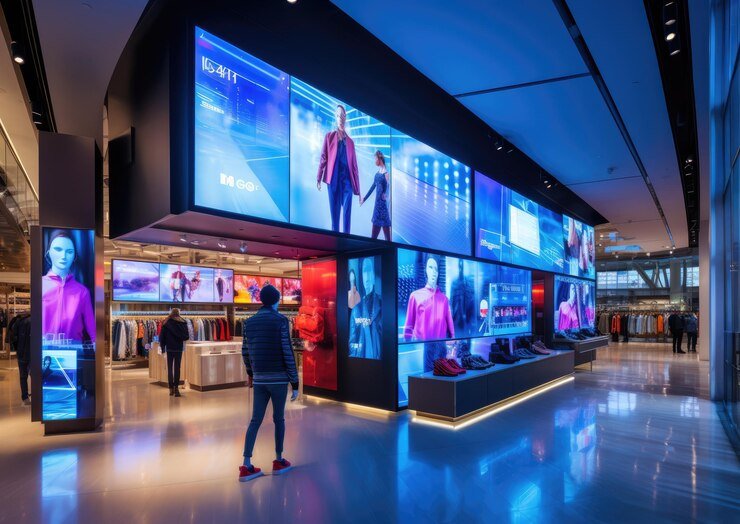Now a days people have little time to pay attention to the advertisements, and the digital marketing concept is searching for ways to attract the consumers’ attention. One of the innovations that has since cropped up is the use of Augmented reality especially when integrated with digital signage. Consumers are getting used to engaging and engaging experiences and thus AR in digital signage provides brands with a way to engage, educate and even entertain their target audience.
What is Augmented Reality Digital Signage?
Augmented reality refers to the live viewing of digital content like images, text or 3D models superimposed onto an image of a real-world scene as captured through a screen. When used on digital signage, AR makes what was once a passive display into an active and engaging one. It means that users can interact with content using their smartphone, tablet or even a pair of AR glasses, so the message a brand delivers can be much more informative and targeted.
How AR Improves Digital Signage?
1. Immersive Customer Engagement
As will be shown, AR can transform simple commercials into experiences. Customers are not just looking at a promotional poster but can engage with a brand’s content in a more active way. For instance, a clothing seller can set an AR screen through which customers get to see how certain clothes would fit them without having to wear them. This not only gets their attention but also builds a much better relationship between the customer and the brand.
2. Personalized Advertising
The incorporation of AR into digital signage can enable the capture of users’ preference and behaviors, making it easier for businesspeople to advertise. For example, retailers are able to address the targeted user in a different manner by using the information about the user’s previous purchases. This personalization results in better content, better engagement and thus better conversion rates.
3. Improved Product Presentations
AR digital signage is also effective in providing brands the chance to show detailed demonstrations of their products. For example, in an electronics store, the company can utilize AR to reveal what is happening inside the product, or how it operates. This can assist consumers in a way in making a better decision when purchasing a product since they have some detailed explanation on how the product will be useful to them.
4. Gamification and Interactive Experiences
When combined with gamification that is achievable through AR, digital signage is highly engaging. Retailers can develop games or tasks that are in augmented reality forms to which customers can engage themselves using a touch screen or a smartphone. Consequently, users are encouraged to spend more time on the content that strengthens brand association, and they come back for more.
Applications of AR in Digital Signage:
1. Retail
Today, the common application of AR digital signage is evident in retailers who are applying the technology to transform shopping experience. From visual displays that enable customers to try a dress virtually to other displays which allow customers to know the features of a product, augmented reality has the potential to revolutionize the shopping experience and increase sales.
2. Real Estate
The use of AR digital signage can in turn be applied to display virtual tours of properties. Many possible consumers can use the display to test out various rooms, designs or renovations all in one place.
3. Events and Exhibitions
Digital signs that use AR can involve the attendees in a particular event through the use of interactive displays. For example, the exhibitors can help the participants to imagine how new products look like, what services they offer or play games with incentives as a way of promoting their products.
4. Healthcare
This information suggests that AR digital signage can also be used in the educational sense by healthcare providers. Inpatients and visitors can use touch screens to learn more about a disease or treatment process or to be informed about advantages of the new medication.
5. Transportation Hubs
AR digital signage can be of help to airports and train stations, mainly because it will help travelers receive information regarding their trips in real-time. AR can help users with directions, or amenities around them or changes in schedules, hence assist them in going through the environment.
Augmented reality in digital signage – the future:
However, with the development of the AR technology, it will be seen that it will be more and more incorporated into digital signage. Future advancement in connectivity 5G, AI, and machine learning are bound to improve the effectiveness of AR and make interaction with the audience faster and real-time. With the declining cost of AR hardware like glasses and headsets, the mass use of AR digital signage will be realized hence extending its use across various industries.
Technology in the form of augmented reality is set to revolutionize the future of digital signage and making static and passive displays become active and interactive. The benefits of adopting AR digital signage include Consumer engagement, which is likely to be higher, The market reach is likely to be more personal, And lastly, there is likely to be effective communication with the consumers. More so, as the AR technology advances, it becomes possible to come up with unique and engaging marketing campaigns and thus AR digital signage is set to be a big player in the advertising market of the future.





